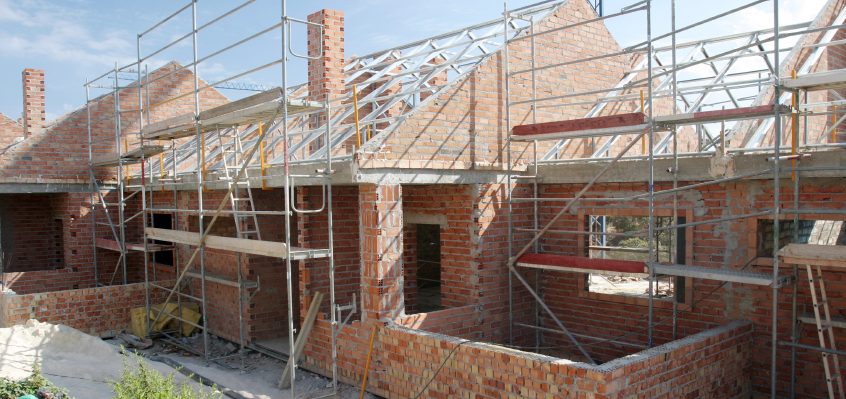The Ultimate How-To Guide For Self-build Homes

Self-build homes are becoming increasingly popular, not only because they allow those looking to buy the opportunity to build their dream home tailored to suit their requirements, but also because nowadays property prices are constantly on the rise, making attaining a reasonably priced home very difficult. This is especially true in areas like London where house prices are increasing at a drastic rate. Whether it’s to cut costs or to build something unique, there are many considerations you will need to bear in mind prior to committing to a self-build.
Working out your budget and getting a mortgage
Once you’ve decided that a self-build may be the way you want to go, you will need to look at how you will finance the project, and realistically what you can afford. It’s difficult to quote an average project cost because there are too many variables involved, such as access to the property and ground conditions. However, we would say that £150,000 would be the minimum you would require to build a three or four bedroom property, but that price can be much higher depending on the location of the project so you will need to take some time to research your chosen area.
Securing a mortgage is another challenge. Typically, when applying for a self-build, mortgage providers will require you to have a slightly larger upfront deposit than if you were applying for a standard mortgage, often requiring up to 25% of the total cost of the build. On top of that, the remaining 75% of the mortgage is not released as one lump sum of money, as a normal mortgage is, instead 5-7 payments are made at frequent intervals in the house building process. This is to ensure that the project is on track and on budget. While this may seem daunting at first, it is an excellent motivational tool to keep your costs low and ensure that you are adhering to your budget.
Don’t forget!
When working out your budget, don’t forget to account for Stamp Duty Land Tax (SDLT). You don’t have to pay this for plots of land that are less than £125,000, but after that, you will have to pay a percentage ratio:
£125,001-£250,000: 1%
£250,001-£500,000: 3%
£500,001-£1,000,000: 4%
The different ways you can build your own home
There are two routes you can go down for your self-build: custom build or kit house.
A custom build can either be designed by yourself, with you also overseeing a large portion of the design and build with a team of contractors, or if you’re not as confident in your own design skills, you can work with a developer to design the house. Whichever route you go down, we would always suggest having an architect double-check the plans for complete peace of mind.
Kit houses are a much simpler process than custom builds. You work with an organisation that produces kit houses and select your preferred pre-designed and built house, which is then delivered to your site and constructed for you. Much of the build is done off-site, and the final house is put together rather like flat pack furniture once it arrives on your site, with the frame of the house constructed in a matter of days. The only thing you may have to organise for your build is the foundations of the home, the rest is taken care of on your behalf.
Which route you go down is dependent on your budget and preference. While custom builds allow you much more control of the design and layout of your home, the construction process is lengthier and there is much more potential for the project to derail and become more expensive. On the other hand, kit builds are pretty much a guaranteed price and are quick to build, but do not offer the creative freedom that you may have chose to self-build for. When choosing your preference, think about your reason for wanting to self-build; was it financial or creative?
Designing your self-build and planning permissions
If you’ve opted for a kit house, then you needn’t worry about designing your home as it will all be pre-designed. However, if you’ve gone down the custom build route, you will need to start planning the layout and design of your home.
This stage of the production should not be thought of lightly, as it can take a good few months to get right! Think carefully about the best use of space, how many bedrooms and bathrooms you need, the best place for the staircase to be placed and the layout of the doors and windows, as these will all play big roles in the functionality and comfort of your home. You should be specific in your plans, but also be prepared to be flexible – even the best-laid plans fall short of the mark sometimes.
If you are using an architect to create your house plan, put together a good brief for them, including which things are high up on your priorities and can’t be sacrificed. The more informative your plan is, the more likely that the architect will create your dream house.
Once your design is complete and you are happy, you will need to submit an application for planning permission. There are two types of planning permission you can apply for: Outline planning permission and full/detailed planning permission.
Outline planning permission is a provisional approval for a house plan that is valid for three years. This is basically a pre-approval for an idea for a house you may have designed but aren’t quite ready to build yet. When you are ready to build, you will need to get the full/detailed planning permission granted based on fully formed building plans. You shouldn’t buy the land for your build until you have gained this approval in case the Local Authority rejects your plan.
Sticking to your budget and money saving tips
First things first; don’t expect your project to come in completely on budget. This rarely happens. Whether it’s from weather delays, delivery holdups or a last minute change to design plans, things happen that can derail your project. The best way to avoid unexpected costs pushing your project over budget is to plan for it. We’d recommend that you include a contingency of 10 to 20 percent of your projected costs in your budget when applying for your mortgage. That way, if you do run over your projected costs slightly, you have the funds available to account for it.
Another tip to ensure you stick to your budget is to make sure that your builder has access to as much information as possible when quoting his costs. This includes things such as the materials you are using for your walls and flooring, as well as how many staircases, doors, beams and light fixtures you’re planning to have. This allows the builder to provide a much more precise quote, so you won’t receive a nasty surprise further down the line.
Once you have finalised your plans and got your quotes, don’t start chopping and changing things! That last minute decision to switch tile materials or add an extra doorway or two could set you back much more than you think.
Quick money saving tips:
- Source materials through your builder – Builders will benefit from discounted rates through trade accounts, so when sourcing materials make use of your team!
- Repurpose old materials – Where you can, try using unused building materials out of skips from other projects. There are various websites that offer this service, and you can find some useful stock at a fraction of the price! Going hand in hand with this, when it comes to your own project, try to reuse and recycle as much of your own waste as possible. Not only will this save you from buying more materials, it will also reduce skip hire costs.
- Get a helping hand – To reduce the price of labour, try to undertake any of the construction tasks you are capable of handling, and ask friends and family to chip in where they can.
- Claim back the VAT – Once your build is complete, you can claim back the VAT on all exempt materials that you used for your project.
- Get insured – While it may be another upfront cost that you don’t want to fork out for, insurance can save you a fortune if something was to go wrong with your project.
Extensions and developments: Permitted developments
When you’re planning your self-build, consider how possible it will be to extend and develop your property. While the home you build may be perfect for now, you never know what could happen in the future; having the opportunity to extend can be invaluable.
If your extension requires planning permission through your Local Authority, this can be a painstakingly slow procedure, often up to eight weeks long, and it’s not unusual for plans to be refused.
The best way to avoid this runaround is to look into what extensions you can build under Permitted Developments. These allow you to make changes to your property without planning permission, but there is a limit to how much volume you can add to your home. A Permitted Development allows you to extend to the rear of the building, and possibly add a loft conversions, as long as the extensions don’t take up more than 50 percent of the surrounding land.
It’s a good idea to check what your Local Authority allows under Permitted Developments prior to buying your land and building your home, as there are other rules regarding proximity to boundary and material choice that may affect the ease in which you can extend your home.
For all the concrete you need to complete your self-build, Neil Sullivan & Sons can help. We supply ready mix, on-site and volumetric concrete to the South East, offering affordable concrete, quick deliveries and an efficient service. Make us your first choice for your concrete supplies to ensure a stress-free process. Get in touch today to discuss this in more detail.



